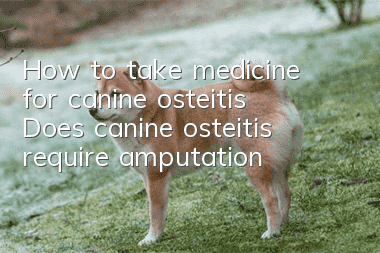How to take medicine for canine osteitis? Does canine osteitis require amputation?

Causes of canine osteitis
1. Exogenous infection. Most cases of osteomyelitis are infected through this route. Pathogenic bacteria infect bone tissue through wounds or surgical incisions. Seen after bite wounds, deep stab wounds, gunshot wounds, open fractures, bone orthopedic surgeries, etc. that directly damage the bone.
2. Infection can also be caused by the spread of purulent inflammation in the soft tissue around the bone.
3. Blood-borne infection mainly occurs in young dogs. It is an infection caused by pathogenic bacteria from infection foci in other parts of the body transferring to bone tissue through blood circulation. Common primary infections include umbilical corditis, pneumonia, gastroenteritis, arthritis, etc.
Key points in diagnosis of canine osteitis
1. X-rays show only soft tissue swelling in the affected areas of the dog in the early stages. About 2 weeks later, there was a silkworm-like destruction area and periosteal ossification with blurred borders.
2. In chronic cases, the bone around the bone destruction area is dense, and there may be "dead bones" in the bone cortex.
3. If there is a sinus, the bone surface may be rough during probing and may even penetrate into the medullary cavity, and bone debris may be flushed out by scour.
Treatment measures for canine osteitis
1. Adequate antibiotics should be applied throughout the body of sick dogs. Broad-spectrum antibiotics are used at the initial stage of the disease and are continued until 1 week after the inflammation disappears.
2. If there is a local abscess or if the medication is ineffective for many days, the wound should be expanded to drain the pus, flush and drain. If there is suspected medullary empyema, surgery should be performed to drill through the bone cortex to drain the pus and reduce pressure. If probing or X-ray examination reveals a "sequestrum" or cavity, surgery will be performed to remove the sequestrum and scrape the sinus wall.
3. If the internal fixation of the fracture is infected, the internal fixation material should not be removed. If the fixation is unstable, the fixation should be strengthened.
4. For dogs with chronic osteomyelitis, systemic medication and local treatment should be adhered to.
5. For those who cannot control inflammation or prevent the spread of inflammation, if it is in the limbs, amputation of the lesion may be considered.
- Is it better for Dogo dogs to have their ears erect or cropped? A case of Dogo dog’s ear erection surgery will tell you
- What do dogs eat to protect their stomach? It is important to protect their stomach and treat gastrointestinal diseases in dogs.
- How to tell if your dog is fat? Is your dog overweight?
- Will your dog catch a cold if you blow the air conditioner? What should you do if your dog catches a cold if you blow the air conditioner?
- What should you pay attention to when your dog drinks water? Don’t be careless when it comes to your dog’s drinking water.
- The dog's mouth bites and shakes. Why does the dog's mouth occasionally shake and bite?
- How to cut a dog's hair? Do you know how to cut a dog's hair correctly?
- Can dogs eat raw eggs? Why can’t dogs eat egg whites?
- Common Dog Problems in Summer How to Deal with Different Dog Problems
- How to keep dogs away from skin diseases. If you do this, will you see if your dog will still be infected with skin diseases?



